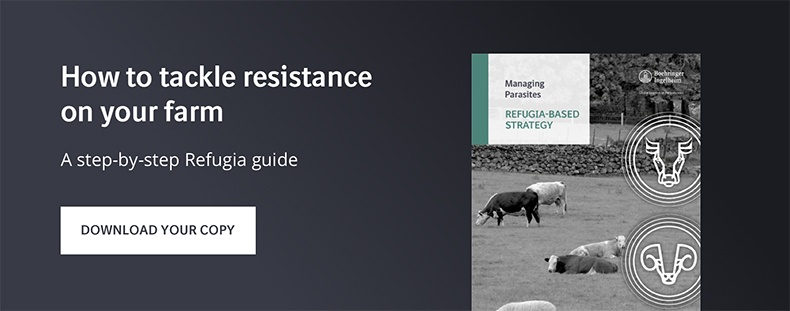Roundworm burden in beef leads to production losses
A roundworm burden in beef cattle can lead to losses in productivity through reduced growth rates and reduced average daily live weight-gain (ADLWG). Controlling and treating roundworms therefore plays an important role in reducing the internal worm burden, reducing production losses and improving profitability for cattle farmers.
Research shows worming can have positive impact on beef production
Reductions in feed intake associated with parasitism can vary considerably over a range of -4% to -77%1. Indeed, research carried out in the U.S. has revealed major improvements to animal health and welfare as well as enhanced performance and productivity through the use of worm control treatments2. Individual trials with beef cattle show the effect of wormers on pregnancy rate range from an increase of 2.4 per cent3 to an increase of 120 percent4, the difference likely reflecting the specific nutritional, environmental and genetic conditions of the animals in the study. The wormer’s effect on the weaning weight ranged from an increase of nearly 0.3 per cent5 to over 13 per cent6. Prevention of worms can therefore have a major impact the productivity of beef cattle.
Parasites impact performance even without clinical signs
Parasites may impact significantly on performance without producing signs of clinical disease. Even subclinical parasitism, where only a few roundworms are present, can impact on productivity. Cattle may not only eat less but their feed efficiency can also be negatively impacted due to disruption of the digestive process. Nutritional resource gets allocated towards staging an immune response against the worm challenge instead of growth and weight gain.
Grazing management practice is key to minimise roundworm
Grazing management practices will heavily influence exposure to roundworm larvae, while on-going preventative practices will minimise losses caused by clinical and sub-clinical parasite infections.
During the grazing season parasite control programmes should take into consideration the farm type, topography and facilities, so that the approach can be matched to the farm’s objectives and attitudes. Seasonality will inevitably impact on climate, plant growth, parasite epidemiology, cattle husbandry, farm management and housing, and thus parasite control. Parasite populations typically increase from mid-July onwards for parasitic gastroenteritis and lungworm infections are more common from July onwards. Map the farm at the start of the grazing season to determine the use of pastures, particularly in terms of parasite risk, when hay and silage aftermaths will become available, and which classes of stock will graze each pasture.
Planned approach to wormer use
Each spring decide whether the parasite control plan will be strategic; adopting a planned approach to wormer use, with whole-group treatments administered at specific risk periods, or whether a targeted approach to treatment, utilising a regular assessment of parasite risk to determine whether treatments are required is more appropriate.
For control of roundworm challenge in groups of youngstock to be effective, strategic worming treatments need to begin early in the grazing season. Thereafter, aim to minimise pasture contamination up to mid-July, by which time the over-wintered population should have declined to insignificant levels. If the approach is targeted, ensure that effective, regular monitoring such as weighing of cattle to assess growth performance is in place, to allow poorer performing individuals not meeting growth targets to be treated.
Close monitoring of pasture quality throughout the grass-growing season will allow farmers to cope with the unpredictability associated with grazing.
Set growth targets for young stock at grass, manage and feed accordingly and use wormers alongside grazing management to ensure that worm challenge does not prevent targets from being met. Growing cattle should be weighed regularly, as it is the only way to accurately monitor performance.
An effective, planned parasite control strategy can overcome the threat posed by all the major worms of cattle. The appropriate use of wormers can alleviate the effects of existing burdens and reduce the risk of subsequent disease.
Best practice is key
Use parasite control products as recommended, using the correct applicator. Accurate dosing can only be achieved if animals are weighed before applying treatments, estimating liveweight by eye is inaccurate and can lead to over or under-dosing.
In order to get the best from parasite control products, farmers should:
- Maintain all equipment and cattle handling facilities
- Use the most appropriate product for the worms present.
- Administer products at the right dose.
- Store and handle products safely and correctly.
- Consult the label and/or datasheet before using a product.
Click here for product legal furniture.
